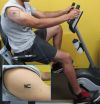(Press-News.org) SAN FRANCISCO, Aug. 13, 2014 — In the future, working up a sweat by exercising may not only be good for your health, but it could also power your small electronic devices. Researchers will report today that they have designed a sensor in the form of a temporary tattoo that can both monitor a person's progress during exercise and produce power from their perspiration.
The team described the approach in one of nearly 12,000 presentations at the 248th National Meeting & Exposition of the American Chemical Society (ACS), the world's largest scientific society, taking place here through Thursday. A brand-new video on the research is available at http://www.youtube.com/watch?v=3_D7JOd07M8&feature=youtu.be.
The device works by detecting and responding to lactate, which is naturally present in sweat. "Lactate is a very important indicator of how you are doing during exercise," says Wenzhao Jia, Ph.D.
In general, the more intense the exercise, the more lactate the body produces. During strenuous physical activity, the body needs to generate more energy, so it activates a process called glycolysis. Glycolysis produces energy and lactate, the latter of which scientists can detect in the blood.
Professional athletes monitor their lactate levels during performance testing as a way to evaluate their fitness and training program. In addition, doctors measure lactate during exercise testing of patients for conditions marked by abnormally high lactate levels, such as heart or lung disease. Currently, lactate testing is inconvenient and intrusive because blood samples must be collected from the person at different times during the exercise regime and then analyzed.
Jia, a postdoctoral student in the lab of Joseph Wang, D.Sc., at the University of California San Diego, and her colleagues developed a faster, easier and more comfortable way to measure lactate during exercise. They imprinted a flexible lactate sensor onto temporary tattoo paper. The sensor contained an enzyme that strips electrons from lactate, generating a weak electrical current. The researchers applied the tattoo to the upper arms of 10 healthy volunteers. Then the team measured the electrical current produced as the volunteers exercised at increasing resistance levels on a stationary bicycle for 30 minutes. In this way, they could continuously monitor sweat lactate levels over time and with changes in exercise intensity.
The team then went a step further, building on these findings to make a sweat-powered biobattery. Batteries produce energy by passing current, in the form of electrons, from an anode to a cathode. In this case, the anode contained the enzyme that removes electrons from lactate, and the cathode contained a molecule that accepts the electrons.
When 15 volunteers wore the tattoo biobatteries while exercising on a stationary bike, they produced different amounts of power. Interestingly, people who were less fit (exercising fewer than once a week) produced more power than those who were moderately fit (exercising one to three times per week). Enthusiasts who worked out more than three times per week produced the least amount of power. The researchers say that this is probably because the less-fit people became fatigued sooner, causing glycolysis to kick in earlier, forming more lactate. The maximum amount of energy produced by a person in the low-fitness group was 70 microWatts per cm2 of skin.
"The current produced is not that high, but we are working on enhancing it so that eventually we could power some small electronic devices," Jia says. "Right now, we can get a maximum of 70 microWatts per cm2, but our electrodes are only 2 by 3 millimeters in size and generate about 4 microWatts — a bit small to generate enough power to run a watch, for example, which requires at least 10 microWatts. So besides working to get higher power, we also need to leverage electronics to store the generated current and make it sufficient for these requirements."
Biobatteries offer certain advantages over conventional batteries: They recharge more quickly, use renewable energy sources (in this case, sweat), and are safer because they do not explode or leak toxic chemicals.
"These represent the first examples of epidermal electrochemical biosensing and biofuel cells that could potentially be used for a wide range of future applications," Wang says.
INFORMATION:
A press conference on this topic will be held Wednesday, August 13, at 11 a.m. Pacific time in the Moscone Center, North Building. Reporters may report to Room 113 in person, or access live video of the event and ask questions at the ACS Ustream channel http://www.ustream.tv/channel/acslive.
The researchers acknowledge funding from the National Science Foundation and Office of Naval Research.
The American Chemical Society is a nonprofit organization chartered by the U.S. Congress. With more than 161,000 members, ACS is the world's largest scientific society and a global leader in providing access to chemistry-related research through its multiple databases, peer-reviewed journals and scientific conferences. Its main offices are in Washington, D.C., and Columbus, Ohio.
To automatically receive news releases from the American Chemical Society, contact newsroom@acs.org.
Note to journalists: Please report that this research is being presented at a meeting of the American Chemical Society.
Follow us: Twitter | Facebook
Title
Wearable biosensors and biofuel cells for continuous non-invasive epidermal monitoring
Abstract
The healthcare industry has recently experienced a major paradigm shift towards wearable biomedical devices. The fabrication of tattoo-based wearable biosensors that are able to monitor chemical constituents residing on the epidermis of the wearer's body are presented. These sensors can monitor lactate generated in human perspiration during exercise through a non-invasive and continuous fashion. The resulting temporal lactate profiles reflect changes in the production of sweat lactate upon varying the exercise intensity. Furthermore, we demonstrate the ability to generate electrical power from human perspiration through the use of epidermal tattoo biofuel cells. Substantial power was generated from human sweat in real-life scenarios. Such skin-worn metabolite tattoo based biosensors and biofuel cells could offer considerable promise for diverse sport, military, and biomedical applications.
Tattoo biobatteries produce power from sweat (video)
2014-08-13
ELSE PRESS RELEASES FROM THIS DATE:
A new look at what's in 'fracking' fluids raises red flags
2014-08-13
SAN FRANCISCO, Aug. 13, 2014 — As the oil and gas drilling technique called hydraulic fracturing (or "fracking") proliferates, a new study on the contents of the fluids involved in the process raises concerns about several ingredients. The scientists presenting the work today at the 248th National Meeting & Exposition of the American Chemical Society (ACS) say that out of nearly 200 commonly used compounds, there's very little known about the potential health risks of about one-third, and eight are toxic to mammals.
The meeting features nearly 12,000 presentations on ...
Passengers who survived terrifying Air Transat flight in 2001 help psychologists uncover new clues about post-traumatic stress vulnerability
2014-08-13
Toronto, Canada – An extraordinary opportunity to study memory and post-traumatic stress disorder (PTSD) in a group of Air Transat passengers who experienced 30 minutes of unimaginable terror over the Atlantic Ocean in 2001 has resulted in the discovery of a potential risk factor that may help predict who is most vulnerable to PTSD.
The study, led by researchers at Baycrest Health Sciences, is published online this week in the journal Clinical Psychological Science – ahead of print publication. It is the first to involve detailed interviews and psychological testing in ...
Why seniors don't eat: It's complicated
2014-08-13
WASHINGTON – More than half of older adults who visit emergency departments are either malnourished or at risk for malnutrition, but not because of lack of access to health care, critical illness or dementia. Despite clear signs of malnutrition or risk of malnutrition, more than three-quarters had never previously been diagnosed with malnutrition, according to the results of a study to be published online tomorrow in Annals of Emergency Medicine ("Malnutrition Among Cognitively Intact, Non-Critically Ill Older Adults in the Emergency Department").
"We were surprised ...
Giant Amazon fish becoming extinct in many fishing communities, saved in others
2014-08-13
An international team of scientists has discovered that a large, commercially important fish from the Amazon Basin has become extinct in some local fishing communities.
The team compared mainstream bioeconomic theory — which policymakers have depended on in order to protect fish populations — with the lesser-known "fishing-down" theory, which predicts that large, high-value, easy-to-catch fish can be fished to extinction.
"Bioeconomic thinking has predicted that scarcity would drive up fishing costs, which would increase price and help save depleted species," said study ...
Gene that controls nerve conduction velocity linked to multiple sclerosis
2014-08-13
Philadelphia, PA, August 13, 2014 – A new study published in The American Journal of Pathology identifies a novel gene that controls nerve conduction velocity. Investigators report that even minor reductions in conduction velocity may aggravate disease in multiple sclerosis (MS) patients and in mice bred for the MS-like condition experimental autoimmune encephalomyelitis (EAE).
A strong tool for investigating the pathophysiology of a complex disease is the identification of underlying genetic controls. Multiple genes have been implicated as contributing to the risk of ...
Clotting drug linked to fewer blood transfusions in joint surgery
2014-08-13
Tranexamic acid has been shown to reduce blood loss during or shortly after major joint surgery (the perioperative stage). However, safety concerns remain because large scale effectiveness studies are lacking.
In the USA, over 1 million hip and knee replacements are performed each year. In
England and Wales the figure is about 180,000.
So a team of US researchers, led by Dr Stavros Memtsoudis at Hospital for Special Surgery, Weill Cornell Medical College, and Dr Jashvant Poeran at Mount Sinai School of Medicine, both in New York, set out to determine the effectiveness ...
The Lancet Diabetes & Endocrinology: 2 out of every 5 Americans expected to develop type 2 diabetes during their lifetime
2014-08-13
Close to half (40%) of the adult population of the USA is expected to develop type 2 diabetes at some point during their lifetime, suggests a major study published in The Lancet Diabetes & Endocrinology. The future looks even worse for some ethnic minority groups, with one in two (> 50%) Hispanic men and women and non-Hispanic black women predicted to develop the disease.
A team of US researchers combined data from nationally representative US population interviews and death certificates for about 600 000 adults to estimate trends in the lifetime risk of diabetes and ...
The Lancet: nearly half of women at risk of preterm birth do not receive cheap drug that could prevent millions of newborn deaths
2014-08-13
A major international study of more than 303 000 births in 29 low-income and middle-income countries has found that only half (52%) of women who are eligible to receive a simple, effective, low-cost treatment to prevent death and disability in their newborn babies are getting it.
The findings, published in The Lancet, highlight striking gaps in the practice of using antenatal (before birth) steroid injections—known to significantly reduce the risk of death, respiratory distress syndrome (a consequence of immature lung development), cerebroventricular haemorrhage (bleeding ...
Dartmouth study demonstrates key brain region in contextual memories
2014-08-13
Dartmouth researchers demonstrate in a new study that a previously understudied part of the brain, the retrosplenial cortex, is essential for forming the basis for contextual memories, which help you to recall events ranging from global disasters to where you parked your car.
The findings appear in the journal The Journal of Neuroscience. A PDF of the study is available on request.
An important aspect of memory is the ability to recall the physical place, or context, in which an event occurred. For example, in recalling emotionally charged events, such as the Sept. ...
Anxiety and amen: Prayer doesn't ease anxiety disorders for everyone, Baylor study finds
2014-08-13
Whether the problem is health, enemies, poverty or difficulty with aging, "Take your burden to the Lord and leave it there," suggested the late gospel musician Charles A. Tindley. But when it comes to easing symptoms of anxiety-related disorders, prayer doesn't have the same effect for everybody, according to a Baylor University researcher.
What seems to matter more is the type of attachment a praying individual feels toward God. According to a Baylor study, those who prayed to a loving and supportive God whom they thought would be there to comfort and protect them in ...


